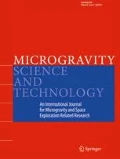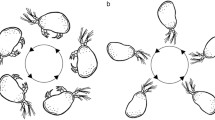Abstract
Manned space missions, as for example to the planet Mars, are a current objective in space exploration. During such long-lasting missions, aquatic bioregenerative life support systems (BLSS) could facilitate independence of resupply from Earth by regenerating the atmosphere, purifying water, producing food and processing waste. In such BLSS, microcrustaceans could, according to their natural role in aquatic ecosystems, link oxygen liberating, autotrophic algae and higher trophic levels, such as fish. However, organisms employed in BLSS will be exposed to high acceleration (hyper- g) during launch of spacecrafts as well as to microgravity (μg) during space travel. It is thus essential that these organisms survive, perform and reproduce under altered gravity conditions. In this study we present the first data in this regard for the microcrustaceas Daphnia magna and Heterocypris incongruens. We found that after hyper-g exposure (centrifugation) approximately one third of the D. magna population died within one week (generally indicating that possible belated effects have to be considered when conducting and interpreting experiments during which hyper-g occurs). However, suchlike and even higher losses could be countervailed by the surviving daphnids’ unaltered high reproductive capacity. Furthermore, we can show that foraging and feeding behavior of D. magna (drop tower) and H. incongruens (parabolic flights) are rarely altered in μg. Our results thus indicate that both species are suitable candidates for BLSS utilized in space.




Similar content being viewed by others
References
Adell, T., Saló, E., van Loon, J.J.W.A., Auletta, G.: Planarians sense simulated microgravity and hypergravity. Biomed Res. Int. 2014 (2014)
Alekseev, V., Sychev, V.N.: Effects of Space Station Conditions on Resting Egg Survivorship and Parameters of Life Cycle in D. Magna 36Th COSPAR Scientific Assembly, Beijing, China (2006)
Amiard-Triquet, C., Rainbow, P.S., Romeo, M. (eds.): Tolerance to Environmental Contaminants. CRC Press (2011)
Andersson, A., Nilsson, D.: Fine structure and optical properties of an ostracode (Crustacea) nauplius eye. Protoplasma 374, 361–374 (1981)
Baranov, V.M., Novikova, N.D., Polikarpov, N.A., Sychev, V.N., Levinskikh, M.A., Alekseev, V.R., Okuda, T., Sugimoto, M., Gusev, O.A., Grigor’ev, A.I.: The Biorisk experiment: 13-month exposure of resting forms of organism on the outer side of the Russian Segment of the International Space Station: Preliminary results. Dokl. Biol. Sci. 426, 267–270 (2009)
Benzie, J.A.H.: The Genus Daphnia (Including Daphniopsis):(Anomopoda, Daphniidae). Kenobi Productions, Ghent (2005)
Blüm, V., Paris, F.: Possible applications of aquatic bioregenerative life support modules for food production in a martian base. Adv. Sp. Res. 31, 77–86 (2003)
Chial, B., Persoone, G.: Cyst-based toxicity tests XIV–application of the ostracod solid-phase microbiotest for toxicity monitoring of river sediments in Flander(s Belgium). Environ. Toxicol. 17, 533–7 (2002)
DIN EN ISO 6341:2013-01: Wasserbeschaffenheit - Bestimmung der Hemmung der Beweglichkeit von Daphnia magna Straus (Cladocera, Crustacea) - Akuter Toxizitäts-Test (2013)
Directorate of Human Spaceflight and Operations: ESA User Guide to Low Gravity Platforms, HSO-K/MS/01/14, Issue 3 revision 0, Chapter 6 Sounding Rockets. pp. 1–32 (2014)
Dodson, S.I., Ryan, S., Tollrian, R., Lampert, W.: Individual swimming behavior of Daphnia: effects of food, light and container size in four clones. J. Plankton Res. 19, 1537–1552 (1997)
Ebert, D.: Ecology, epidemiology, and evolution of parasitism in Daphnia [Internet]. Bethesda (MD): National Library of Medicine (US), National Center for Biotechnology Information. Available from: https://www.ncbi.nlm.nih.gov/books/NBK2036/ (2005)
Fischer, J., Schoppmann, K., Knie, M., Laforsch, C.: Responses of microcrustaceans to simulated microgravity (2D-Clinorotation) - preliminary assessments for the development of bioregenerative life support systems (BLSS). Microgravity Sci. Technol. 28, 337–344 (2015)
Fryer, G.: Functional morphology and the adaptive radiation of the daphniidae (branchiopoda: Anomopoda). Philos. Trans. R. Soc. B Biol. Sci. 331, 1–99 (1991)
Ganning, B.: On the ecology of Heterocypris salinus, H. incongruens and Cypridopsis aculeata (Crustacea: Ostracoda) from Baltic brackish-water rockpools. Mar. Biol. 8, 271–279 (1971)
Golder, D., Rana, S., Paria, D.S., Jana, B.B.: Human urine is an excellent liquid waste for the culture of fish food organism, Moina micrura. Ecol. Eng. 30, 326–332 (2007)
Gonzales, J.M., Brown, P.B.: Nile tilapia Oreochromis niloticus as a food source in advanced life support systems: Initial considerations. Adv. Sp. Res. 38, 1132–1137 (2006)
Goździejewska, A., Tucholski, S.: Zooplankton of fish culture ponds periodically fed with treated wastewater. Pol. J. Environ. Stud. 20, 67–79 (2011)
Grant, I.F., Egan, E.A., Alexander, M.: Measurement of rates of grazing of the ostracod Cyprinotus carolinensis on blue-green algae. Hydrobiologia 106, 199–208 (1983)
Häder, D.-P.D., Richter, P., Lebert, M.: Signal transduction in gravisensing of flagellates. Signal Transduct. 6, 422–431 (2006)
Ijiri, K.: Medaka fish had the honor to perform the first successful vertebrate mating in space. Fish Biol. J. Medaka. 7, 1–10 (1995)
Ijiri, K., Mizuno, R., Narita, T., Ohmura, T., Ishikawa, Y., Yamashita, M., Anderson, G., Poynter, J., MacCallum, T.: Behavior and reproduction of invertebrate animals during and after a long-term microgravity: space experiments using an Autonomous Biological System (ABS). Biol. Sci. Space. 12, 377–388 (1998)
Ishikawa, Y., Kobayashi, K., Mizutani, H., Kawasaki, Y., Koike, J., Ijiri, K., Yamashita, M., Sugiura, K., Poynter, J., Maccallum, T., Others, Anderson, G.: Concluding remarks of autonomous biological systems (ABS) experiments. Biol. Sci. Sp. 12, 394–399 (1998)
Jander, R.: Ecological aspects of spatial orientation. Annu. Rev. Ecol. Syst. 171–188 (1975a)
Jander, R.: Interaction of light and gravity orientation in Daphnia pulex Fortschritte der Zoologie, pp 174–84 (1975b)
Jeschke, J.M., Tollrian, R.: Density-dependent effects of prey defences. Oecologia 123, 391–396 (2000)
Kirk, K.L.: Suspended clay reduces Daphnia feeding rate. Freshw. Biol. 25, 357–365 (1991)
Lampert, W.: Feeding and Nutrition in Daphnia. In: Peters, R.H., de Bernardi, R. (eds.) Daphnia. pp. 143–192. Memorie Dell’istituto Italiano Di Idrobiologia 45, Pallanza, Italy (1987)
Lampert, W.: Daphnia: model herbivore, predator and prey. Pol. J. Ecol. 54, 607–620 (2006)
Marthy, H.-J.: Microgravity and Development of Aquatic Animals ESA, Fourth European Symposium on Life Sciences Research in Space, pp 255–257 (1990)
McMahon, J.W., Rigler, F.H.: Mechanisms Regulating the Feeding Rate of Daphnia magna Straus. Can. J. Zool. 41, 321–332 (1963)
Meisch, C.: Freshwater Ostracoda of Western and Central Europe. In: Schwoerbel, J., Zwick, P. (eds.) Süßwasserfauna Von Mitteleuropa. Spektrum Akademischer Verlag, Heidelberg, Berlin (2000)
Miličić, D.M., Majstorović, A.P., Pavković-Lučić, S.B., Savić, T.T.: Behaviour and food selection of Heterocypris incongruens (Ostracoda). Crustaceana 88, 1097–1110 (2015)
Neale, J.W.: Some factors influencing the distribution of Recent British Ostracoda. Pubbl. Stn. Zool. Napoli II 33, 247–307 (1964)
Niihori, M., Mogami, Y., Naruse, K., Baba, S.A.: Development and swimming behavior of Medaka fry in a spaceflight aboard the Space Shuttle Columbia (STS-107). Zoolog. Sci. 21, 923–931 (2004)
Niihori, M., Poynter, J., Nelson, S. G., Mogami, Y.: Small-package Life Support Ecological System for Long-lasting Space Experiment: Feasibility Studies on the Application to Fish Experiments. J. Japan Soc. Microgravity Appl. 24, 320–324 (2007)
Novikova, N., Gusev, O., Polikarpov, N., Deshevaya, E., Levinskikh, M., Alekseev, V., Okuda, T., Sugimoto, M., Sychev, V. N., Grigoriev, A.: Survival of dormant organisms after long-term exposure to the space environment. Acta Astronaut. 68, 1574–1580 (2011)
OECD: Guidline for Testing Chemicals: 202 Daphnia sp., Acute Immobilisation Test and Reproduction Test (1984)
OECD: Guidline For Testing Chemicals: 211 Daphnia magna Reproduction Test 1–21 (1998)
Oleszczuk, P.: The evaluation of sewage sludge and compost toxicity to Heterocypris incongruens in relation to inorganic and organic contaminants content. Environ. Toxicol. 22, 587–596 (2007)
Oleszczuk, P.: Heterocypris incongruens as a tool to estimate sewage sludge toxicity. Environ. Toxicol. Chem. 27, 864–72 (2008)
Omori, K., Oguchi, M., Takeuchi, T.: Development of zooplankton culture subsystem for a closed ecological recirculating aquaculture system (CERAS). Acta Astronaut. 58, 82–87 (2006)
Porter, K. G., Gerritsen, J., Orcutt, J.D.: The effect of food concentration on swimming patterns, feeding behavior, ingestion, assimilation, and respiration by Daphnia. Limnol. Oceanogr. 27, 935–949 (1982)
Ricci, C., Caprioli, M., Villa, A.: Microgravity and hypergravity effect on survival and reproduction of microinvertebrates. J. Gravit. Physiol. 5, P125–6 (1998)
Rossi, V., Benassi, G., Belletti, F., Menozzi, P.: Colonization, population dynamics, predatory behaviour and cannibalism in Heterocypris incongruens (Crustacea: Ostracoda). J. Limnol. 70, 102–108 (2011)
Rossi, V., Gandolfi, A., Menozzi, P.: Egg diapause and clonal structure in parthenogenetic populations of Heterocypris incongruens (Ostracoda). Hydrobiologia. 320, 45–54 (1996)
Ruyters, G., Friedrich, U.: From the Bremen Drop Tower to the international space station ISS - Ways to weightlessness in the German Space Life Sciences Program. Signal Transduct. 6, 397–405 (2006)
Schembri, P. J.: Locomotion, feeding, grooming and the behavioural responses to gravity, light and hydrostatic pressure in the stage I zoea larvae of Ebalia tuberosa (Crustacea: Decapoda: Leucosiidae). Mar. Biol. 72, 125–134 (1982)
Schmit, O., Rossetti, G., Vandekerkhove, J., Mezquita, F.: Food selection in Eucypris virens (Crustacea: Ostracoda) under experimental conditions. Hydrobiologia 585, 135–140 (2007)
Schultz, T. W.: The fine structure of the Ephippium of Daphnia pulex (Crustacea: Cladocera). Trans. Am. Microsc. Soc. 96, 313–321 (1977)
Schwartzkopf, S. H.: Design of a controlled ecological life support system. Bioscience 42, 526–535 (1992)
Sychev, V. N., Levinskikh, M.A., Shepelev, Y.Y.: The biological component of the life support system for a martian expedition. Adv. Sp. Res. 31, 1693–1698 (2003)
Sychev, V. N., Levinskikh, M. A., Podolsky, I. G.: Biological component of life support systems for a crew in long-duration space expeditions. Acta Astronaut. 63, 1119–1125 (2008)
Vannier, J., Abe, K., Ikuta, K.: Feeding in myodocopid ostracods: functional morphology and laboratory observations from videos. Mar. Biol. 132, 391–408 (1998)
Von Beckh, H.J.A.: Experiments with Animals and Human Subjects under Sub- and Zero-gravity Conditions during the Dive and Parabolic Flight. J. Aviat. Med. 25, 235–241 (1954)
von Kampen, P., Kaczmarczik, U., Rath, H.J.: The new Drop Tower catapult system. Acta Astronaut. 59, 278–283 (2006)
Wagner, I., Braun, M., Slenzka, K., Posten, C.: Photobioreactors in Life Support Systems. In: Posten, C., Feng Chen, S. (eds.) Microalgae Biotechnology, pp 143–184. Springer International Publishing, Cham (2016)
Acknowledgements
The authors acknowledge that this study forms a part of the Ph.D thesis of Jessica Fischer, who received a scholarship by the Helmholtz Space Life Sciences Research School (SpaceLife). Further financial support was provided by the German Aerospace Center (DLR, Grant No. 50WB1029) on behalf of the Bundesministerium für Wirtschaft und Technologie (BMWi) and the European Space Agency (ESA-GBF-program, contract No. 4000103571). The authors would like to thank M. Huber for determining of the thoracic beat frequency of D. magna and F. Scheller for measuring the duration the ostracods spent on food pieces. The ZARM Fab mbH team (Bremen, Germany), the Novespace team (Bordeaux, France), B. Trotter, B. Wolfschoon-Ribeiro, and R. Sigl provided excellent support during the drop tower and the parabolic flight experiments. The authors are grateful to PD Dr. R. Hemmersbach, PD Dr. R. Matzke-Karasz, I. Schrank, Q. Herzog, and L. Oehme for manuscript editing.
Author information
Authors and Affiliations
Corresponding author
Additional information
Author Disclosure Statement
No competing financial interests exist.
Rights and permissions
About this article
Cite this article
Fischer, J., Schoppmann, K. & Laforsch, C. Life History Responses and Feeding Behavior of Microcrustacea in Altered Gravity – Applicability in Bioregenerative Life Support Systems (BLSS). Microgravity Sci. Technol. 29, 241–249 (2017). https://doi.org/10.1007/s12217-017-9545-x
Received:
Accepted:
Published:
Issue Date:
DOI: https://doi.org/10.1007/s12217-017-9545-x




